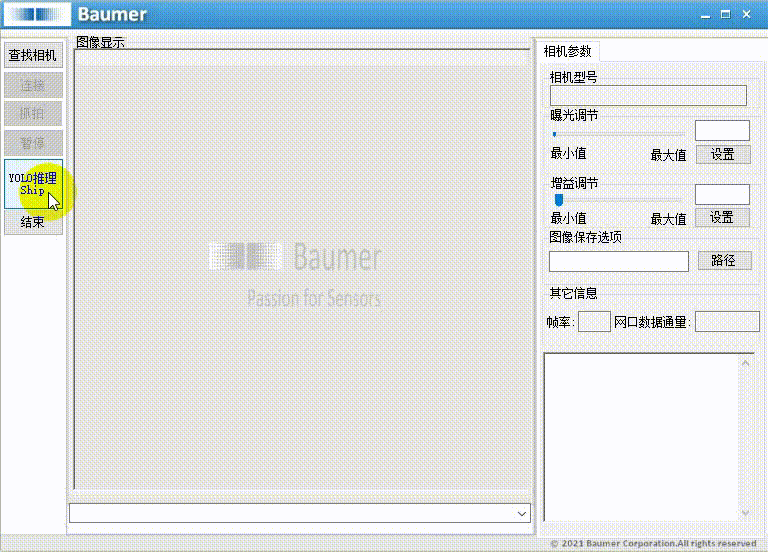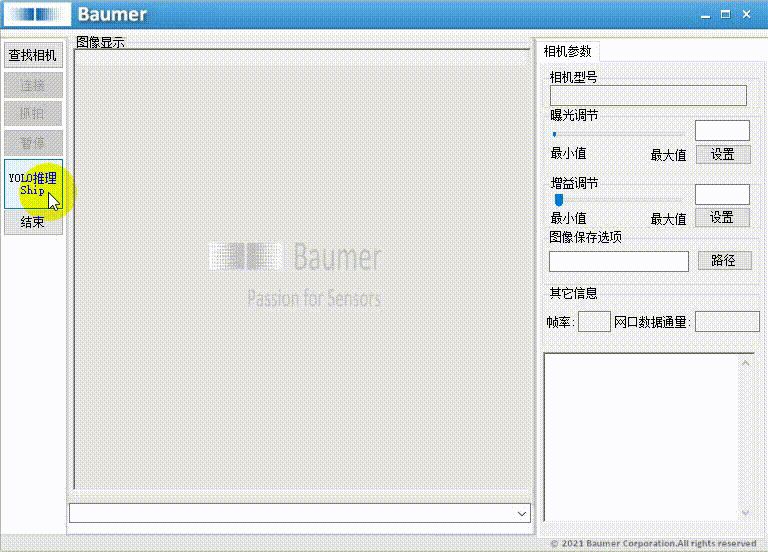
Baumer工业相机堡盟工业相机如何通过YoloV8深度学习模型实现轮船检测识别(C#代码UI界面版)
- 工业相机使用YoloV8模型实现轮船检测识别
- 工业相机通过YoloV8模型实现轮船检测识别的技术背景
- 在相机SDK中获取图像转换图像的代码分析
- 源码下载链接
- 工业相机通过YoloV8模型实现轮船检测识别的行业应用
- 关键技术细节
工业相机使用YoloV8模型实现轮船检测识别
本项目集成了 YOLOv8 检测模型 与 C#图形界面工具,实现了包括图片、文件夹、视频与摄像头等多种输入方式的实现轮船检测识别。
Baumer工业相机堡盟相机是一种高性能、高质量的工业相机,可用于各种应用场景,如物体检测、计数和识别、运动分析和图像处理。
Baumer的万兆网相机拥有出色的图像处理性能,可以实时传输高分辨率图像。此外,该相机还具有快速数据传输、低功耗、易于集成以及高度可扩展性等特点。
Baumer工业相机由于其性能和质量的优越和稳定,常用于高速同步采集领域,通常使用各种图像算法来提高其捕获的图像的质量。
本文以Baumer工业相机作为案例进行演示,实现将工业相机的图像或者本地图像导入Yolo模型从而实现轮船检测识别等功能。
工业相机通过YoloV8模型实现轮船检测识别的技术背景
本文通过C#中实现一个简单的UI界面,用于将YoloV8模型实现轮船检测识别
用户可以通过该界面执行以下操作:
-
转换相机图像为Mat图像:通过YoloV8模型实现轮船检测识别
-
转换本地图像为mat图像:通过YoloV8模型实现轮船检测识别
通过这个UI界面,用户能够在实时应用机器视觉数据处理时快速有效地进行操作,无需深入了解图像数据的底层处理过程。这个简单的介绍旨在为开发人员提供一个明确的方向,以便开始构建此类应用程序,并且该程序主要用于演示目的。
在相机SDK中获取图像转换图像的代码分析
本文介绍使用Baumer工业相机,实现将图像转换为Bitmap图像,再转换Mat图像,导入到Yolo模型进行推理,输出实现轮船检测识别的结果。
工业相机图像转换Bitmap图像格式和Mat图像重要核心代码
csharp
//将相机内部图像内存数据转为bitmap数据
System.Drawing.Bitmap bitmap = new System.Drawing.Bitmap((int)mBufferFilled.Width, (int)mBufferFilled.Height,(int)mBufferFilled.Width,System.Drawing.Imaging.PixelFormat.Format8bppIndexed, (IntPtr)((ulong)mBufferFilled.MemPtr + mBufferFilled.ImageOffset));
#region//Mono图像数据转换。彩色图像数据转换于此不同
System.Drawing.Imaging.ColorPalette palette = bitmap.Palette;
int nColors = 256;
for (int ix = 0; ix < nColors; ix++)
{
uint Alpha = 0xFF;
uint Intensity = (uint)(ix * 0xFF / (nColors - 1));
palette.Entries[ix] = System.Drawing.Color.FromArgb((int)Alpha, (int)Intensity,(int)Intensity, (int)Intensity);
}
bitmap.Palette = palette;
#endregion
string strtime = DateTime.Now.ToString("yyyyMMddhhmmssfff");
string saveimagepath = pImgFileDir + "\\" + strtime + ".brw";
//使用Bitmap格式保存
bitmap.Save(saveimagepath, System.Drawing.Imaging.ImageFormat.Bmp);
//用bitmap转换为mat
OpenCvSharp.Mat Matgray1 = OpenCvSharp.Extensions.BitmapConverter.ToMat(bitmap);本地文件图像转换Bitmap图像格式和Mat图像重要核心代码
C#环境下代码如下所示:
csharp
if (imagePaths.Count() == 0)
{
LoadImagePaths("test_img");
}
string currentImagePath = imagePaths[currentImageIndex];
// 显示到pictureBoxA
pictureBoxA.Image.Dispose(); // 释放上一张图片资源,避免内存泄漏
pictureBoxA.Image = new Bitmap(currentImagePath);
image_path = currentImagePath;
currentImageIndex = (currentImageIndex + 1) % imagePaths.Count;
OnNotifyShowRecieveMsg("检测中,请稍等......");
//textBox1.Text = "检测中,请稍等......";
//pictureBox2.Image = null;
Application.DoEvents();
image = new Mat(image_path);
float ratio = Math.Min(1.0f * inpHeight / image.Rows, 1.0f * inpWidth / image.Cols);
int neww = (int)(image.Cols * ratio);
int newh = (int)(image.Rows * ratio);
Mat dstimg = new Mat();
Cv2.Resize(image, dstimg, new OpenCvSharp.Size(neww, newh));
Cv2.CopyMakeBorder(dstimg, dstimg, 0, inpHeight - newh, 0, inpWidth - neww, BorderTypes.Constant);Mat图像导入YoloV8模型重要核心代码
C#环境下代码如下所示:
csharp
// 定义 ONNX 模型的路径
string onnxModelPath = "model/Ship_detection.onnx";
// 定义输入图像的形状
OpenCvSharp.Size inputShape = new OpenCvSharp.Size(640, 640);
// 从 ONNX 模型文件加载网络
if(net==null)
net = CvDnn.ReadNetFromOnnx(onnxModelPath);
string[] modelClassify = { "BULK CARRIER", "CONTAINER SHIP", "GENERAL CARGO", "OIL PRODUCTS TANKER", "PASSENGERS SHIP", "TANKER", "TRAWLER", "TUG", "VEHICLES CARRIER", "YACHT"};
if (imagePaths.Count() == 0)
{
LoadImagePaths("test_img");
}
string currentImagePath = imagePaths[currentImageIndex];
// 显示到pictureBoxA
pictureBoxA.Image.Dispose(); // 释放上一张图片资源,避免内存泄漏
pictureBoxA.Image = new Bitmap(currentImagePath);
image_path = currentImagePath;
if (pictureBoxA.Image == null)
{
return;
}
currentImageIndex = (currentImageIndex + 1) % imagePaths.Count;
OnNotifyShowRecieveMsg("检测中,请稍等......");
Application.DoEvents();
image = new Mat(image_path);
dt1 = DateTime.Now;
// 调用识别图像的函数,并传入图像路径、阈值、网络、输入形状和分类类别列表
//result_image = Recognize(image, 0.35, net, inputShape, modelClassify);
result_image = RecognizeMat(image, 0.35, net, inputShape, modelClassify);
// 获取计算结束时间
dt2 = DateTime.Now;
// 显示输出的图像
pictureBoxA.Image = new Bitmap(result_image.ToMemoryStream());
// 显示推理耗时时间
OnNotifyShowRecieveMsg("推理耗时:" + (dt2 - dt1).TotalMilliseconds + "ms");
csharp
static Mat RecognizeMat(Mat imgInput, double threshold, Net net, OpenCvSharp.Size inputShape, string[] modelClassify)
{
using (Mat img = imgInput)
{
int inpHeight = inputShape.Height; // 输入图像的高度
int inpWidth = inputShape.Width; // 输入图像的宽度
// 对图像进行预处理,调整尺寸
Mat image = img;
float ratio = Math.Min(1.0f * inpHeight / image.Rows, 1.0f * inpWidth / image.Cols);
int neww = (int)(image.Cols * ratio);
int newh = (int)(image.Rows * ratio);
//// 将图像调整为模型需要的大小
//Mat dstimg = new Mat();
//Cv2.Resize(image, dstimg, new OpenCvSharp.Size(neww, newh));
//Cv2.CopyMakeBorder(dstimg, dstimg, 0, inpHeight - newh, 0, inpWidth - neww, BorderTypes.Constant);
//Mat BN_image = CvDnn.BlobFromImage(dstimg); // 将调整后的图像转换为Blob格式
//// 配置图片输入数据 // 将 blob 设置为网络的输入
//net.SetInput(BN_image);
//// 从图像生成用于网络输入的 blob
//Mat blob = CvDnn.BlobFromImage(img, 1 / 255.0, inputShape, new Scalar(0, 0, 0), false);
////Mat blob = CvDnn.BlobFromImage(img, 1.0 / 255.0, inputShape, new Scalar(0, 0, 0), true, false);
// 将 blob 设置为网络的输入
//net.SetInput(blob);
//// 从图像生成用于网络输入的 blob
Mat img0 = img;
Mat blob0 = CvDnn.BlobFromImage(img0, 1 / 255.0, new OpenCvSharp.Size(inputShape.Width, inputShape.Height), swapRB: true, crop: false);
net.SetInput(blob0);
// 执行前向传播获取输出
Mat output = net.Forward();
// 此处可能需要根据 C# 中 OpenCV 的特性来处理转置操作
output = ReshapeAndTranspose(output);
// 获取图像的行数(高度)
int height = img.Height;
// 获取图像的列数(宽度)
int width = img.Width;
// 计算宽度的缩放因子
double xFactor = (double)width / inputShape.Width;
// 计算高度的缩放因子
double yFactor = (double)height / inputShape.Height;
// 初始化分类类别、得分和检测框的列表
List<string> classifys = new List<string>();
List<float> scores = new List<float>();
List<Rect> boxes = new List<Rect>();
List<Double> maxVales = new List<Double>();
List<OpenCvSharp.Point> maxloces = new List<OpenCvSharp.Point>();
// 遍历输出的行
for (int i = 0; i < output.Rows; i++)
{
// 获取当前行的检测框数据
using (Mat box = output.Row(i))
{
// 在框数据的特定范围中找到最小值、最大值及其位置
OpenCvSharp.Point minloc, maxloc;
double minVal, maxVal;
// Mat classes_scores = box.ColRange(4, 5);//GetArray(i, 5, classes_scores);
// double curmates0 = box.At<float>(0);
double curmates1 = box.At<float>(4);
int collength = box.Cols;
int rowlength = box.Rows;
Mat curmates = box.ColRange(4, box.Cols);
//Cv2.MinMaxLoc(box.ColRange(4, box.Cols), out minVal, out maxVal, out minloc, out maxloc);
Cv2.MinMaxLoc(box.ColRange(4, box.Cols), out minVal, out maxVal, out minloc, out maxloc);
int classId = maxloc.Y;
if (classId == 0)
{
// 获取对应类别的得分
float score = (float)maxVal;
// 如果得分大于阈值
if (score > threshold)
{
// 将得分添加到得分列表
scores.Add(score);
// 将类别添加到类别列表
classifys.Add(modelClassify[classId]);
// 获取框的原始坐标
float x = box.At<float>(0, 0);
float y = box.At<float>(0, 1);
float w = box.At<float>(0, 2);
float h = box.At<float>(0, 3);
// 计算调整后的坐标
int xInt = (int)((x - 0.5 * w) * xFactor);
int yInt = (int)((y - 0.5 * h) * yFactor);
int wInt = (int)(w * xFactor);
int hInt = (int)(h * yFactor);
// 将调整后的框坐标添加到框列表
boxes.Add(new Rect(xInt, yInt, wInt, hInt));
}
}
}
}
// 执行非极大值抑制操作
int[] indices;
CvDnn.NMSBoxes(boxes, scores, 0.25f, 0.45f, out indices);
// 遍历非极大值抑制操作后的索引
foreach (int i in indices)
{
// 获取对应的类别、得分和框
string classify = classifys[i];
float score = scores[i];
Rect box = boxes[i];
// 获取框的坐标和尺寸
// 在图像上绘制矩形框
Cv2.Rectangle(img, box, new Scalar(0, 255, 0), 3);
// 生成类别和得分的标签文本
string label = $"{classify}: {score:F2}";
// 在图像上添加标签文本
Cv2.PutText(img, label, new OpenCvSharp.Point(box.X, box.Y - 10), HersheyFonts.HersheySimplex, 0.5, new Scalar(0, 255, 0), 2);
}
// 将图像复制输出返回
Mat result_image0 = img.Clone();
return result_image0;
// 将处理后的图像保存为文件
// Cv2.ImWrite("result.jpg", img);
}
}代码实现演示(实现轮船检测识别)

源码下载链接
C# WinForms工业相机+本地图像 通过YoloV8深度学习模型实现轮船检测识别 源码
工业相机通过YoloV8模型实现轮船检测识别的行业应用
工业相机 + YOLOv8 实现轮船检测识别的 6 大行业落地场景
(全部来自 2024-2025 年公开源码、专利及论文)
| 行业/场景 | 业务痛点 | 工业相机/硬件形态 | YOLOv8 技术方案 & 关键指标 | 公开源码/数据集 |
|---|---|---|---|---|
| ① 港口船舶流量监控 | 人工统计误差大、AIS 盲区 | 塔架 4K/8K 云台工业相机 30× 变焦 | YOLOv8-tile 2048×2048 切片推理,overlap 0.3,检测 50 ms/切片,准确率 94 % | GitHub: ships_detection671 |
| ② SAR 卫星舰船检测 | 图像分辨率低,舰船占比小 | 机载/星载 SAR → 工业 GPU 服务器 | 改进 YOLOv8:增加 4× 下采样层 + EMA 注意力 + WIoU 损失,SSDD 数据集 mAP@0.5 提升至 91.2 % | |
| ③ 无人机海岸巡检 | 小人-大船比例差异大,小目标易漏 | 无人机挂载 5 MP 全局快门相机 + RTK | SF-YOLO(YOLOv8 改进)+ 空间信息感知模块,Tiny-Person 数据集 mAP 94.9 %,模型仅 3 M | |
| ④ 河道/船闸过闸管理 | 夜航、逆光、大雾干扰 | 星光级 2 MP 工业相机 + 激光补光 | YOLOv8n 量化 3.1 MB,RK3588 边缘盒 40 ms/帧,误报 <2 % | CSDN 博客源码 |
| ⑤ 海上风电运维 | 运维船靠近风机需实时预警 | 塔架 8 K 可见光 + 红外双光相机 | YOLOv8-seg 实例分割,船体 IoU 0.85,2 s 内联动声光报警 | 中国光学期刊网论文 |
| ⑥ 海关缉私/边防 | 高速快艇、夜间偷渡 | 固定式 12 MP 长焦工业相机阵列 | YOLOv8 + DeepSort 跟踪,速度 0.5 m/s 可测,轨迹自动回传指挥中心 | GitHub: ships_detection671 |
关键技术细节
小目标增强
• 在 YOLOv8 中新增 4× 下采样特征图(160×160)+ EMA 注意力,显著改善 <10 px 小舰船检测。
轻量化部署
• Jetson Orin Nano INT8 量化后模型 5 MB,640×640 输入 25 ms/帧。
多源数据融合
• SAR 图像与可见光工业相机结果级联,提升全天候识别鲁棒性。
合规
• 港口/边防场景需在监控区域张贴告示,原始视频 72 h 自动覆盖,符合《数据安全法》。
一键体验
• 完整源码 + 训练数据集:GitHub VisionMillionDataStudio/ships_detection671